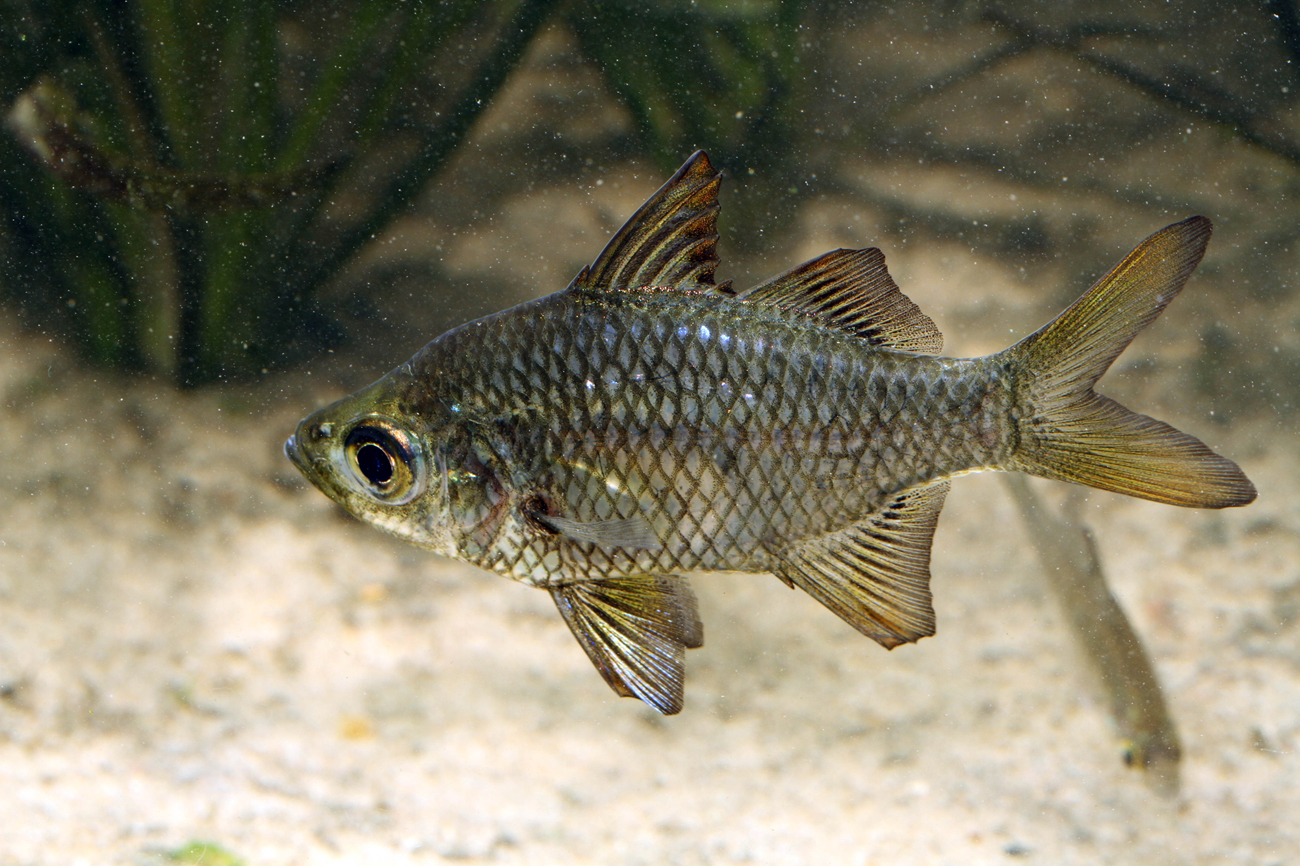Macleay's Glassfish, Ambassis macleayi (Castelnau 1878)

Macleay's Glassfish, Ambassis macleayi, from Lake Kununurra just above the diversion dam in the town of Kununurra, Ord River, December 2015. Source: Dave Wilson / Aquagreen. License: All rights reserved
Macleay's Glassfish, Ambassis macleayi (Castelnau 1878)
More Info
|
Distribution |
Found in northern Australia in a number of river systems from the Carson River, Western Australia, to the Jardine River, Queensland. The species also occurs in New Guinea. Inhabits the margins of freshwater streams and swamps, usually among aquatic vegetation. |
|
Features |
Dorsal fin VII, I, 9-11; Anal fin III, 9-11; Pectoral fin 14-15. Body laterally compressed, elongate-oval shaped, relatively deep; greatest body depth 47.2-49.3% SL; head length 38.2 to 44.8 % SL; snout length 8.2 to 10.1% SL; eye large, diameter 13.4 to 17.2% SL; gill rakers on lower limb of 1st arch 24-29; lateral line incomplete or in two sections, first dorsally to below spinous portion of dorsal with 5-14 tubed scales, second midlaterally on caudal peduncle with 0-6 pored scales; single supraorbital spine; nasal spine absent. Scales large, cycloid; vertical scale rows 27-28; horizontal scale rows 12-13; cheek scale rows 2. Dorsal fin deeply notched, origin behind origin of ventral fins; 1st dorsal spine small, projecting forward; anal fin opposite soft rays of dorsal; height of first dorsal fin 32.2 to 40.3 % SL; 2nd dorsal spine longer than 3rd dorsal spine; 3rd anal spine longer than 2nd anal spine; anal and dorsal fins with scaly basal sheath; pectoral fins of moderate size, ventral fins large; caudal fin forked with rounded tips. |
|
Size |
To 9 cm SL. |
|
Colour |
Semi-transparent olive to dark greenish-brown to yellow/golden with dark scale edges forming a network pattern over most of body; dark patch at pectoral fin base. |
|
Feeding |
Feeds on micro-crustaceans, aquatic and terrestrial insects and some algae. |
|
Biology |
Breeds throughout the year spawning over aquatic vegetation onto which the adhesive eggs become attached. Eggs are spawned in batches of several hundred eggs over a 7 day period. Eggs are small (0.3-0.5 mm diameter) and adhesive. Larvae develop rapidly after hatching at around 1.6 mm TL and begin feeding after 3 days. Metamorphosis is complete after 18 days when they reach 10 mm TL. |
|
Fisheries |
Used as an aquarium species. |
|
Conservation |
Listed as ‘least concern’ on the IUCN Red List of Threatened Species. |
|
Remarks |
Ambassis macleayi is common with a patchy distribution throughout its range. |
|
Similar Species |
Ambassis macleayi can be distinguished by other species in the genus Ambassis in having a relatively deep body, a high gill raker count, a dark patch at the pectoral-fin base, and an interrupted lateral line. |
|
Etymology |
The species is named macleayi in recognition of the important contributions to fish taxonomy made by the early ichthyologist William Macleay. |
|
Species Citation |
Pseudoambassis macleayi Castelnau 1878, Proc. Linn. Soc. N.S.W. (1)3(1): 43. Type locality: Norman River, Gulf of Carpentaria, QLD. |
|
Author |
Bray, D.J. & Thompson, V.J. 2019 |
|
Resources |
Macleay's Glassfish, Ambassis macleayi (Castelnau 1878)
References
Allen, G.R. 1982. Inland Fishes of Western Australia. Perth : Western Australian Museum 86 pp. 6 figs 20 pls.
Allen, G.R. 1989. Freshwater Fishes of Australia. Neptune, New Jersey : T.F.H. Publications 240 pp., 63 pls.
Allen, G.R., Midgley, S.H. & Allen, M. 2002. Field Guide to the Freshwater Fishes of Australia. Perth : Western Australian Museum 394 pp.
Allen, G.R., Storey, A.W. & Yarrao, M. 2008. Freshwater Fishes of the Fly River Papua New Guinea. Tabubil, Papua New Guinea : Ok Tedi Mining 216 pp.
Allen, G.R. & Burgess, W.E. 1990. A review of the glass-fishes (Ambassidae) of Australia and New Guinea. Records of the Western Australian Museum, Supplement 34: 139-206.
Castelnau, F.L. de 1878. Notes on the fishes of the Norman River. Proceedings of the Linnean Society of New South Wales 1 3(1): 41-51.
Grant, E.M. 1975. Guide to Fishes. Brisbane : Queensland Government, Co-ordinator General’s Department 640 pp.
Grant, E.M. 2002. Guide to Fishes. Redcliffe : EM Grant Pty Ltd 880 pp.
Huey, J.A., Baker, A.M. & Hughes, J.M. 2010. High levels of genetic structure in the Australian freshwater fish, Ambassis macleayi. Journal of the North American Benthological Society 29 1148–1160 https://doi.org/10.1899/09-093.1
Jenkins, A., Kullander, F.F. & Tan, H.H. 2009. Ambassis macleayi. The IUCN Red List of Threatened Species 2009: e.T169355A6610614. http://dx.doi.org/10.2305/IUCN.UK.2009-2.RLTS.T169355A6610614.en. Downloaded on 26 August 2019.
Larson, H.K. & Martin, K.C. 1990. Freshwater Fishes of the Northern Territory. Northern Territory Museum of Arts and Sciences Handbook Series Number 1. Darwin : Northern Territory Museum of Arts and Sciences 102 pp. 73 figs.
Leggett, R. & Merrick, J.R. 1987. Australian Native Fishes for Aquariums. Artarmon : J.R. Merrick Publications 241 pp. 142 figs.
Merrick, J.R. & Schmida, G.E. 1984. Australian Freshwater Fishes Biology and Management. Sydney : J.R. Merrick 409 pp. figs 280 col. figs.
Pusey, B.J., Kennard, M.J. & Arthington, A.H. 2004. Freshwater Fishes of North-eastern Australia. Collingwood, Victoria : CSIRO Publishing 684 pp.
Unmack, P.J. 2001. Biogeography of Australian freshwater fishes. Journal of Biogeography 28: 1053-1089.
Whitley, G.P. 1935. Fishes from Princess Charlotte Bay, North Queensland. Records of the South Australian Museum (Adelaide) 5(3): 345-365 figs 1-11




